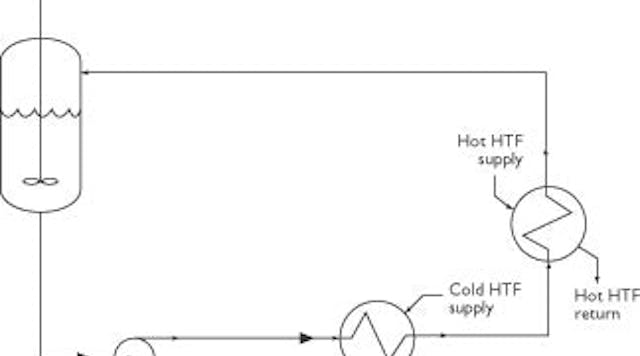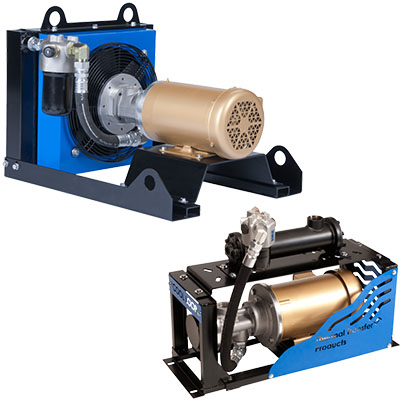Top 10 Thermal Innovations Driving DVS Heat Transfer Systems Forward
Wiki Article
The Role of Heat Transfer Systems in Sustainable Energy Solutions for the Future
Heat transfer systems are vital in the pursuit for sustainable power solutions. They enhance thermal power administration, enhancing the efficiency of renewable technologies. By employing systems like convection, conduction, and radiation, these systems minimize power losses. Their role in solar thermal and geothermal applications is especially substantial. As developments arise, the capacity for additional innovations increases important concerns regarding future power approaches. What growths will shape the landscape of sustainable energy?Understanding Heat Transfer Equipments

The Importance of Thermal Power Management
Reliable thermal energy administration is vital for maximizing power effectiveness and lessening waste in different systems. By controling temperature and enhancing Heat transfer processes, companies can substantially minimize energy intake and operational prices. Efficient management entails the execution of advanced innovations and practices that keep track of and manage thermal problems within systems, ensuring that energy resources are made use of efficiently. Additionally, correct thermal power management contributes to lowering greenhouse gas discharges, lining up with worldwide sustainability objectives. It likewise improves system integrity and efficiency, causing enhanced product top quality and longer devices life expectancy. Eventually, focusing on thermal energy management is a vital step in the direction of producing extra lasting energy services and cultivating an accountable method to energy intake in industrial and household contexts.Applications of Heat Transfer in Renewable Resource
While numerous sustainable energy sources guarantee sustainability, the efficient application of Heat transfer plays a crucial role in their performance. In wind power systems, Heat transfer is used for turbine element cooling, improving performance and longevity. Geothermal power counts on efficient Heat exchange in between the planet's subsurface and the liquid circulating in the system, taking full advantage of power removal. Biomass power procedures likewise take advantage of Heat transfer, as it aids in transforming organic products into usable gas with pyrolysis and gasification. Furthermore, in hydropower, keeping optimal temperature levels in reservoirs can enhance energy outcome. Each of these applications demonstrates the important significance of Heat transfer systems in improving renewable resource modern technologies, eventually adding to a much more sustainable energy future.Enhancing Solar Thermal Power Performance
As solar thermal power systems remain to evolve, boosting their efficiency has actually become crucial for maximizing energy result. Breakthroughs in Heat transfer innovations, such as improved thermal storage materials and innovative Heat exchangers, play a considerable function in enhancing efficiency. By using innovative materials that have premium thermal conductivity, systems can transfer and catch Heat much more properly. In addition, integrating radar that comply with the sun's course assurances that collection agencies obtain suitable solar direct exposure throughout the day. Making use of nanotechnology in solar absorbers can additionally increase energy absorption prices. Including automated control systems aids control temperature levels and manage energy distribution successfully, leading to minimized losses and improved overall system effectiveness. These enhancements lead the way for even more sustainable solar thermal power remedies in the future.Geothermal Heating: A Lasting Option
Geothermal heating presents a sensible choice for sustainable power, supplying considerable ecological benefits with reduced greenhouse gas emissions. Its effectiveness and cost-effectiveness make it an attractive alternative to typical furnace. Nevertheless, difficulties connected to execution needs to be addressed to optimize its possible effect.Ecological Benefits of Geothermal
Typical heating techniques add considerably to greenhouse gas exhausts, geothermal home heating provides a compelling alternative that reduces environmental effect. By using the Earth's internal Heat, geothermal systems use a sustainable energy source, considerably minimizing reliance on fossil gas. This method produces very little carbon exhausts, making it a cleaner choice for commercial and property home heating. Additionally, geothermal systems advertise energy efficiency, as they require much less power compared to traditional home heating systems. DVS Heat Transfer Systems. The application of geothermal energy additionally assists in minimizing air contamination, boosting local air top quality and public health. As a sustainable option, geothermal heating supports climate modification reduction initiatives, placing itself as a necessary element in the change towards a greener futureEffectiveness and Cost-Effectiveness
How does geothermal home heating determine up in terms of performance and cost-effectiveness contrasted to typical heating unit? Geothermal home heating demonstrates premium efficiency, usually attaining a coefficient of performance (POLICE) of 3 to 5, implying it produces three to 5 devices of Heat for every like it device of electrical energy consumed. This effectiveness converts right into lower operating expense, specifically in areas with secure geothermal resources. First installment expenses can be higher than standard systems; nonetheless, long-term financial savings on power costs and minimized maintenance expenses can balance out these ahead of time investments. Furthermore, many governments incentivize geothermal systems through refunds and tax credit scores, my site enhancing their cost-effectiveness. Overall, geothermal home heating becomes a financially practical and lasting alternative to more standard home heating services.Implementation Difficulties and Solutions
Various difficulties can impede the widespread application of geothermal heating unit, regardless of their clear advantages as a lasting power remedy. High initial installment costs usually prevent homeowners and investors, making funding a significant barrier. Additionally, the geographical restrictions of suitable geothermal websites limit access in certain areas. Regional laws and permitting processes can also complicate job development, bring about delays. In addition, public recognition and understanding of geothermal systems stay low, impeding acceptance. To deal with these challenges, targeted education and learning campaigns can improve open secret, while federal government incentives can minimize economic concerns. Working together with regional authorities to simplify regulations might help with smoother job authorizations, eventually promoting the fostering of geothermal home heating as a practical, lasting energy alternative.Innovations in Heat Transfer Technologies
Developments in Heat transfer modern technologies play an essential function in boosting power efficiency and sustainability. Advanced Heat exchangers and phase change materials go to the forefront of these advancements, providing considerable improvements in thermal monitoring. These modern technologies not just enhance energy use however also add to lowering environmental impact in different applications.Advanced Heat Exchangers
Advanced Heat exchangers play a necessary duty in boosting power performance throughout various applications in lasting power services. These gadgets help with the transfer of Heat between two or even more liquids, considerably reducing energy usage in processes such as industrial heating, cooling, and power generation. Innovations in materials and layout, such as making use of nanofluids and small setups, have brought about improved thermal efficiency and reduced size requirements. In addition, improvements in electronic tracking and control systems permit maximized procedure, further boosting efficiency. By lessening waste Heat and taking full advantage of energy healing, advanced Heat exchangers add to reduce carbon footprints and sustain the shift toward eco pleasant innovations. Their proceeded advancement is vital for attaining global energy sustainability goals.
Phase Change Materials
The combination of stage change products (PCMs) right into Heat transfer innovations stands for a considerable innovation in energy management and efficiency. PCMs soak up and release thermal power during their phase modifications, enabling efficient temperature level law in structure products and energy systems. By saving excess Heat throughout peak periods and releasing it when need boosts, PCMs add to fill changing and power preservation - DVS Heat Transfer Systems. This capability boosts the performance of eco-friendly power systems, especially in solar thermal applications. Additionally, PCMs can boost the thermal comfort of interior atmospheres, reducing dependence on conventional heating and cooling down methods. As advancements in PCM formulations proceed to emerge, their function in lasting energy solutions is positioned to grow, using encouraging opportunities for future study and application
Future Leads for Heat Transfer in Lasting Energy
As the demand Visit This Link for lasting power services proceeds to increase, the duty of Heat transfer systems is becoming significantly vital in forming future innovations. Developments in styles and materials are anticipated to improve performance in Heat transfer, decreasing power losses in various applications. The integration of advanced thermal storage space systems, such as stage modification products and thermochemical storage space, will make it possible for better administration of energy sources. Research right into nanofluids and biomimetic Heat exchangers might additionally optimize thermal performance. The fostering of clever modern technologies will certainly allow for real-time surveillance and flexible control of Heat transfer processes. These innovations are poised to greatly add to the overall effectiveness and sustainability of power systems, leading the means for an extra energy-efficient future.Regularly Asked Inquiries
How Can People Implement Heat Transfer Systems at Home?

People can implement Heat transfer systems at home by installing energy-efficient appliances, using radiant heat, and optimizing insulation. These measures enhance power effectiveness, lower expenses, and advertise lasting methods in property environments.

What Are the Expenses Connected With Installing Heat Transfer Equipments?
The expenses connected with installing Heat transfer systems differ extensively, normally including tools, installment labor, and upkeep. Factors such as system kind, home dimension, and local policies substantially affect the total expense included.Exist Federal Government Rewards for Heat Transfer System Installations?
Government motivations for Heat transfer system installments differ by region and can include tax credit reports, discounts, and grants. These economic benefits aim to encourage adoption, eventually advertising energy performance and lowering ecological influence within communities.How Do Heat Transfer Systems Influence Power Expenses?
Heat transfer systems significantly influence power bills by enhancing power efficiency. By boosting the transfer of Heat, these systems reduce energy usage, leading to lower utility prices and creating a more lasting strategy to power monitoring.What Upkeep Is Required for Heat Transfer Systems?
Upkeep for Heat transfer systems consists of regular inspections, cleansing of components, examining fluid degrees, ensuring correct insulation, and replacing worn parts. These tasks help maintain efficiency, prevent malfunctions, and lengthen the system's operational life-span.These systems assist in the motion of thermal power from one medium to another, making it possible for the transfer of Heat for cooling, heating, or power generation purposes. Geothermal power depends on efficient Heat exchange in between the planet's subsurface and the liquid distributing in the system, making best use of energy extraction. Furthermore, geothermal systems advertise energy efficiency, as they need much less energy contrasted to traditional home heating systems. Advanced Heat exchangers play a vital duty in boosting energy performance throughout different applications in lasting energy services. Heat transfer systems notably influence energy costs by optimizing energy efficiency.
Report this wiki page